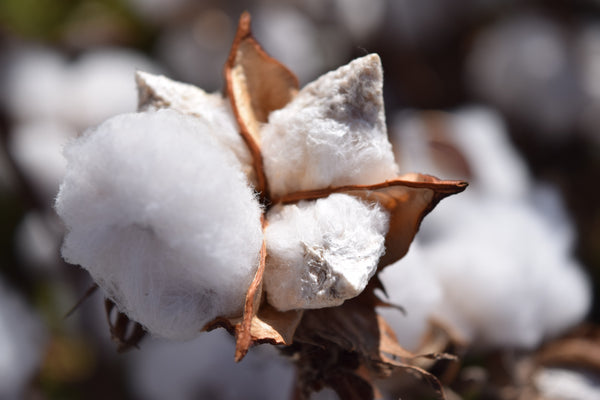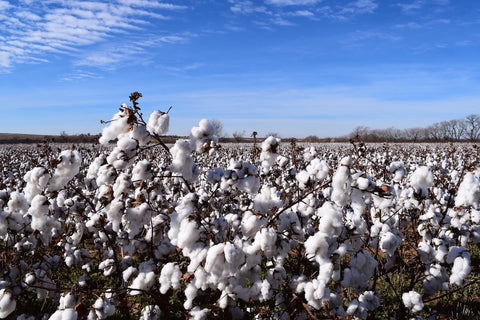Cotton is one of the oldest textile fibers and is still used in around 50% of all textiles worldwide. A large part of the OGNX collection is also made from organic cotton. But what is the difference between normal and organic cotton? In our article you will find out everything about the advantages and disadvantages of the popular natural fiber, what organic cotton is all about and why it is important to protect people and the environment.

Photo by @dietitian.mama on Unsplash
What are the advantages and disadvantages of cotton
Cotton grows in tropical and subtropical areas in over 80 countries. The world's largest producers are India, China, USA, Brazil and the countries of sub-Saharan Africa. In many developing countries, cotton is the most important foreign currency earner. They are often grown in remote rural regions and can help to integrate rural households into economic cycles. But growing the soft natural fiber also poses some problems. Find out everything about the advantages and disadvantages here:
Advantages:
- Natural, skin-friendly and soft
- Elastic and particularly durable due to its high abrasion resistance
- Very absorbent
- Renewable raw material
- Biodegradable
Disadvantages:
Although cotton offers many advantages and is therefore used in around 50% of all textiles worldwide, the degradation and use of the cotton-balled flower is repeatedly criticized due to the dangerous working conditions and the poor ecological balance.
-
Pesticides and fertilization:
Since conventional cotton is often grown in monocultures, the plants are very susceptible to pests and the soil is put under great strain. A high use of pesticides should help counteract both of these problems. According to the Munich Environmental Institute , the cotton plant is sprayed with all kinds of agricultural poisons an average of 20 times per season. However, the use of chemical weapons endangers biodiversity and reduces the nutrient content of the soil. But the poison is not only very dangerous for the plants and the soil, but also for the farmers who come into direct contact with the pesticides.
-
Genetic engineering:
According to the TransGen database, genetically modified seeds are currently used in the fight against pests on around two thirds of the world's cotton-growing area. It is questionable whether this actually increases yields, but what is certain is that genetic manipulation destroys the ecological balance. In addition to limiting genetic diversity, it also promotes the uncontrollable spread and the development of resistance.
-
Water consumption:
The cotton plant is grown in subtropical areas because it needs a lot of light and sun. But in addition to light and sun, the cotton plant also needs a lot of water and this is particularly rare in the growing areas. Natural irrigation is usually not possible and artificial irrigation must be used.
-
Exploitation:
Seed prices are determined by large international corporations. Genetic manipulation is intended to help farmers achieve higher yields. In reality, however, genetic modification does not promote yield, but rather only increases farmers' dependence on large seed companies. Since the genetically modified plants do not reproduce themselves, farmers have to buy new, expensive seeds every year. However, this often means financial ruin for poor farmers.

What is the difference between cotton and organic cotton
As already mentioned above, the cultivation of conventional cotton involves many risks for people and nature. Farmers with organic certification agree that an independent certification body will check at least once a year whether the strict regulations of organic farming are being adhered to. This can eliminate a large part of the problems.
You can see why OGNX also relies on the use of organic cotton here:
-
No genetic manipulation:
Genetic modifications to seeds are prohibited in organic cotton cultivation. In this way, the natural reproduction of plants is promoted and the habitat of nearby plants and animals is protected.
-
Less water consumption:
Although organic cotton plants also need to be watered frequently, consumption is significantly lower than with conventional cultivation. On the one hand, this is because the soil can store more water due to the crop rotation (alternating plants) that is common in organic farming. On the other hand, stored rainwater is primarily used for irrigation in the organic cotton fields.
-
Preservation of biodiversity:
Instead of chemical pesticides, only natural fertilizers such as manure or compost are used during cultivation. In conjunction with regular crop rotation, this has a positive effect on the yield of the plants and biodiversity is maintained. Unlike conventional cultivation, the plants may only be harvested by hand and not with artificial defoliants.
-
Support for smaller farmers:
Farmers receive better wages when growing organic cotton. By becoming independent from large seed and pesticide companies, small farming structures are also promoted.

What is GOTS and Oeko-Tex
While the "organic" certification controls the cultivation of cotton, the GOTS and Oeko-Tex seals regulate compliance with ecological and social standards during fiber processing. Quality assurance is carried out along the entire textile supply chain by an independent testing center
-
The Global Organic Textile Standard (GOTS) is one of the best-known and most widespread eco-textile seals. The GOTS standard defines requirements that guarantee the end consumer a high level of product safety with regard to environmentally friendly and socially responsible production of textile products. Textiles must consist of 90% natural fibers (cotton, wool, etc.), at least 70% of which come from controlled organic cultivation (kbA) or controlled organic animal husbandry (kbT). GOTS bans all particularly dangerous groups of chemicals.
- The Oeko-Tex seal checks the residual pollutants on the end product. It is a globally consistent, independent testing and certification system for raw, semi-finished and finished textile products at all levels of processing as well as accessory materials.
Unfortunately, certification with the GOTS and Oeko-Tex seal is very time-consuming and expensive. While our materials and producers are usually all GOTs or Oeko-Tex certified, after intensive consideration we have currently actively decided against having the OGNX brand certified as well. On the one hand, we do not want to pass on the high costs associated with certification to you as a customer and on the other hand, we are currently investing our financial and human resources into sourcing new and even more sustainable materials. Through close contact with our manufacturers and regular visits to them, we personally ensure compliance with the highest social standards.
